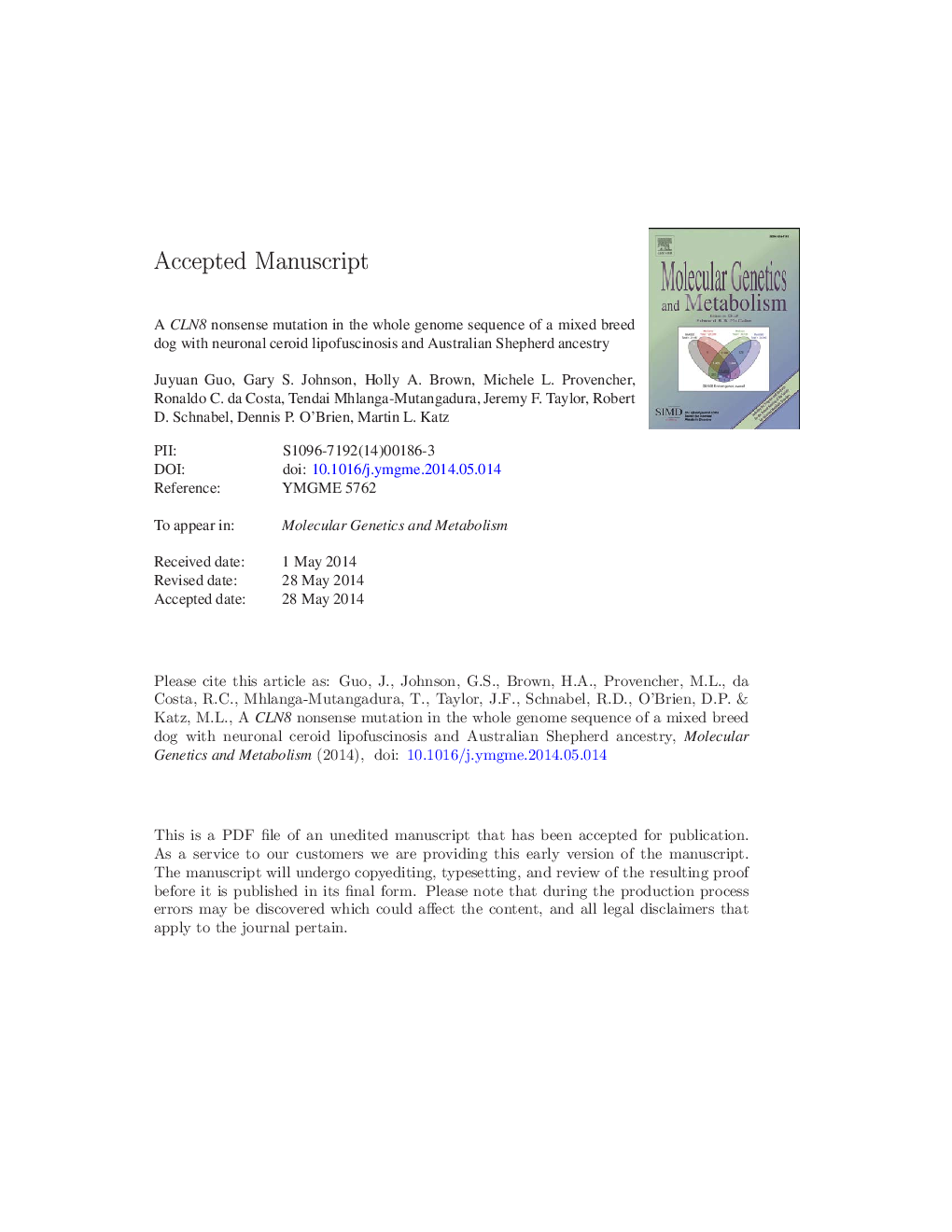| کد مقاله | کد نشریه | سال انتشار | مقاله انگلیسی | نسخه تمام متن |
|---|---|---|---|---|
| 10833589 | 1065798 | 2014 | 30 صفحه PDF | دانلود رایگان |
عنوان انگلیسی مقاله ISI
A CLN8 nonsense mutation in the whole genome sequence of a mixed breed dog with neuronal ceroid lipofuscinosis and Australian Shepherd ancestry
دانلود مقاله + سفارش ترجمه
دانلود مقاله ISI انگلیسی
رایگان برای ایرانیان
کلمات کلیدی
موضوعات مرتبط
علوم زیستی و بیوفناوری
بیوشیمی، ژنتیک و زیست شناسی مولکولی
زیست شیمی
پیش نمایش صفحه اول مقاله

چکیده انگلیسی
The neuronal ceroid lipofuscinoses (NCLs) are hereditary neurodegenerative diseases characterized by seizures and progressive cognitive decline, motor impairment, and vision loss accompanied by accumulation of autofluorescent lysosomal storage bodies in the central nervous system and elsewhere in the body. Mutations in at least 14 genes underlie the various forms of NCL. One of these genes, CLN8, encodes an intrinsic membrane protein of unknown function that appears to be localized primarily to the endoplasmic reticulum. Most CLN8 mutations in people result in a form of NCL with a late infantile onset and relatively rapid progression. A mixed breed dog with Australian Shepherd and Blue Heeler ancestry developed neurological signs characteristic of NCL starting at about 8Â months of age. The signs became progressively worse and the dog was euthanized at 21Â months of age due to seizures of increasing frequency and severity. Postmortem examination of the brain and retinas identified massive accumulations of intracellular autofluorescent inclusions characteristic of the NCLs. Whole genome sequencing of DNA from this dog identified a CLN8:c.585G>A transition that predicts a CLN8:p.Trp195* nonsense mutation. This mutation appears to be rare in both ancestral breeds. All of our 133 archived DNA samples from Blue Heelers, and 1481 of our 1488 archived Australian Shepherd DNA samples tested homozygous for the reference CLN8:c.585G allele. Four of the Australian Shepherd samples tested heterozygous and 3 tested homozygous for the mutant CLN8:c.585A allele. All 3 dogs homozygous for the A allele exhibited clinical signs of NCL and in 2 of them NCL was confirmed by postmortem evaluation of brain tissue. The occurrence of confirmed NCL in 3 of 4 CLN8:c.585A homozygous dogs, plus the occurrence of clinical signs consistent with NCL in the fourth homozygote strongly suggests that this rare truncating mutation causes NCL. Identification of this NCL-causing mutation provides the opportunity for identifying dogs that can be used to establish a canine model for the CLN8 disease (also known as late infantile variant or late infantile CLN8 disease).
ناشر
Database: Elsevier - ScienceDirect (ساینس دایرکت)
Journal: Molecular Genetics and Metabolism - Volume 112, Issue 4, August 2014, Pages 302-309
Journal: Molecular Genetics and Metabolism - Volume 112, Issue 4, August 2014, Pages 302-309
نویسندگان
Juyuan Guo, Gary S. Johnson, Holly A. Brown, Michele L. Provencher, Ronaldo C. da Costa, Tendai Mhlanga-Mutangadura, Jeremy F. Taylor, Robert D. Schnabel, Dennis P. O'Brien, Martin L. Katz,